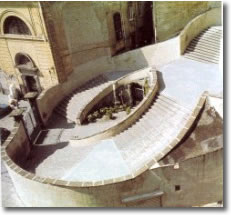
- Stairway of the Church of S. Giovanni a Carbonara
Because of the nature of Naples' subsoil, the people have always dug out tufo and other materials needed for building such as sand, pozzolan and lapilli. The dug-out hollows were never abandoned, but utilised as rain cisterns or as cisterns connected to aqueducts; beneath Naples, therefore, there has always ben running water which could be gained access to by mens of the wells found in every dwelling.
Three aqueducts ran below the ity: the della Bolla Aqueduct of Greek origin, the Roman Augustus Aqueduct, and the del Carmignano Aqueduct of 1600. These three aqueducts which cross over and exchange their water, have resulted in the existence of a complex network of underground passageways and cisterns to which all the buildings built up to 1885 are in one way or another connected;1885 was the year that a plague necessitated the building of the pressure aqueduct, which outdated all the running water aqueducts.
In 1885, it was possible to climb down one of the 4628 wells and tour the underground city in all its length and width from Santa Caterina a Formielloto Monte di Dio, from Ponti Rossi to Capo Misero, and from San Giovanni a Carbonara to the Sanità. In order to take possession of the city, many conquerors had the idea of cutting off the aqueducts; in 537, for example, Belisarius, who commanded Justinian's army in the Italian campaign against the Goths, got to Naples and concealed a whole regiment of horsemen in the cavern of Sportiglione, below Capodichino, while he himself set up camp in front of the gate of Santa Sofia, which is now San Giovanni a Carbonara.
According to Melisurgo, when Belisarius cut off the aqueducts, he exclaimed: "...we'll make these Neapolitans surrender by making them thirty." However, fate had it that one of his soldiers, Isauro, workdìed his way along an underground passage of the ancient delle Bolla Aqueduct and afet a few metres, saw the light from the bottom of a well; he climbed up it by using the footholds of the well-diggers and found himself at the centre of the garrison guarding the Santa Sofia Gate.
That night, some of Belisarius's soldiers climbed up the same well, overcame the guards and opened the gates, so permitting the troops to conquer the city. In 1442, the troops of alfonso I of Aragon, with Diomede Carafa in command, set up camp in the same place. Alfonso I was an educated man and had read about Belisarius, and so gave Carafa orders to find the same point of access.
Carafa contacted two well-diggers, Aniello Ferraro and Roberto Esposito, who led him to the house of "Mastro Citiello Cosetore", a tailor who lived with his wife "Donna Ciccarella" and children"Elena and Leone" right in front of the Santa Sofia gate, where the Bovio school now stands and where there used to be a well beneath if tailor's house. This time, Alfonso I's sailors climbed the well since they were more expert in the use of ropes and ladders. So, for the second
The places change, but not so the underground passageways, the wells and the ancient cisterns; the lattere were widened during the Second World War so that they could be used as shelters.